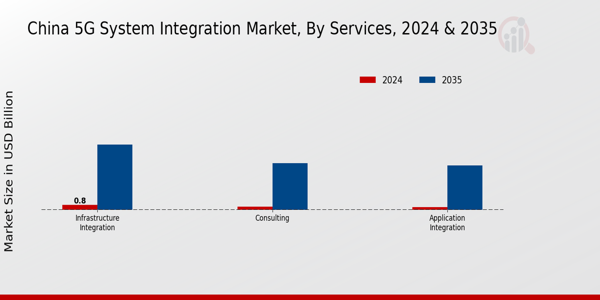China 5G System Integration Market Overview
As per MRFR analysis, the China 5G System Integration Market Size was estimated at 1.36 (USD Billion) in 2023.The China 5G System Integration Market is expected to grow from 1.74(USD Billion) in 2024 to 25.13 (USD Billion) by 2035. The China 5G System Integration Market CAGR (growth rate) is expected to be around 27.492% during the forecast period (2025 - 2035)
Key China 5G System Integration Market Trends Highlighted
The landscape of the China 5G System Integration Market is being shaped by a number of important factors. The growing cooperation between telecom operators and system integrators, which is improving the effectiveness and dependability of network services, is one noteworthy trend.Chinese telecom behemoths are concentrating on developing strong infrastructures to support the quick rollout of 5G technology. Given the market's competitiveness and the government's drive for technical improvement, this developing synergy is essential. Furthermore, the growing need for smart city solutions is fueling expansion in the field of 5G system integration.
China is aggressively supporting smart city projects that use 5G technology to enhance urban administration and services as part of its national strategy. System integrators are creating solutions that can easily integrate with current technologies as a result of this emphasis on smarter infrastructure.Artificial intelligence and the Internet of Things (IoT), which are becoming more popular in Chinese manufacturing and healthcare sectors, present opportunities. It is becoming essential for businesses to integrate 5G with these technologies as they seek to innovate and improve operational efficiency.
Startups and established businesses alike can investigate solutions that successfully incorporate 5G systems thanks to the Chinese government's investment initiatives and regulations aimed at promoting technical growth.Additionally, recent patterns show that cybersecurity is given a lot of weight in system integration plans. Businesses are prioritizing safe solutions as the potential of cyber threats rises with the expansion of 5G networks.
This feature highlights the significance of safety in any integration process and demonstrates the increased understanding of the hazards involved. A time of profound change propelled by cooperation, technical convergence, and calculated investments is shown by the general momentum in the China 5G System Integration Market.

Source: Primary Research, Secondary Research, MRFR Database and Analyst Review
China 5G System Integration Market Drivers
Rapid Expansion of 5G Network Infrastructure
China has been investing heavily in its telecommunications infrastructure, with the government aiming to establish a comprehensive 5G network to support both urban and rural areas. The Ministry of Industry and Information Technology (MIIT) reported that as of 2022, China had built over 1.4 million 5G base stations, which accounted for more than 70% of the global total.
This massive infrastructure investment not only facilitates faster connections and higher data transfer rates but also embodies the commitment of major Chinese telecom companies such as China Mobile and China Telecom in expanding 5G capabilities across various sectors including healthcare, education, and smart city development.As a result, this ongoing expansion is expected to significantly drive growth in the China 5G System Integration Market by boosting demand for integrated solutions that help manage and optimize these expanding networks.
Growing Demand for Enhanced Mobile Connectivity
With the increasing reliance on mobile devices for everyday activities, there is a tremendous demand for enhanced mobile connectivity solutions in China. A report from the China Internet Network Information Center (CNNIC) highlighted that there were over 1 billion smartphone users in China as of mid-2022.
This represents a 10% annual growth in mobile internet users, driving the need for robust 5G system integration to support advanced applications such as augmented reality (AR), virtual reality (VR), and the Internet of Things (IoT).As consumers and businesses seek to leverage these technologies, telecom operators are accelerating the rollout of 5G services, making the China 5G System Integration Market an attractive segment for technology providers.
Government Support and Policy Initiatives
The Chinese government has implemented several supportive policies aimed at fostering the development and adoption of 5G technologies. The '14th Five-Year Plan' outlines strategic goals for the digital economy, placing significant emphasis on the acceleration of 5G network deployment.
Furthermore, recent statements from the State Council indicate that investments in 5G technology are expected to exceed 1 trillion RMB by 2025. Such government backing not only facilitates funding for the necessary infrastructure but also encourages collaboration among various technology and telecommunications firms, propelling the growth of the China 5G System Integration Market.This synergistic approach ensures that necessary resources and knowledge are shared, leading to rapid advancements in system integration solutions.
China 5G System Integration Market Segment Insights
5G System Integration Market Services Insights
The Services segment of the China 5G System Integration Market plays a crucial role in the overall market dynamics, reflecting the increasing demand for comprehensive solutions that cater to the unique challenges of 5G technology deployment.This segment encompasses various aspects, including Consulting, Infrastructure Integration, and Application Integration, each of which serves distinct yet interconnected functions pivotal for the successful implementation and optimization of 5G systems.Consulting is vital as it guides organizations in strategizing their 5G integration through feasibility analyses and tailored solutions designed to meet specific needs.
This expertise is essential considering the rapid technological advancements and evolving regulatory frameworks in China.Infrastructure Integration focuses on deploying essential hardware and networking components to facilitate seamless connectivity and reliable performance, addressing the complexity of integrating diverse systems and ensuring infrastructure scalability to accommodate future growth.Meanwhile, Application Integration emphasizes equipping businesses with customized applications that leverage 5G capabilities to enhance operational efficiency and user experience across various industries such as healthcare, manufacturing, and smart cities.
The Chinese government's push towards digital transformation and innovation supports the growth of these service areas, as enterprises strive to harness the full potential of 5G systems. This segment is expected to gain prominence, dealing with the burgeoning trend of Internet of Things (IoT) expansion, where effective integration services are crucial for maximizing the value of 5G connectivity.Overall, the Services segment within the China 5G System Integration Market stands out for its complexity and significance, making it instrumental in driving market growth and adoption of enhanced technological solutions across various verticals.

Source: Primary Research, Secondary Research, MRFR Database and Analyst Review
5G System Integration Market Vertical Insights
The China 5G System Integration Market focuses on various vertical segments that are key to the country’s rapid technological advancement. Among these, Manufacturing is highly prominent, as it leverages 5G to enhance automation and operational efficiency, resulting in smarter factories.
The Energy and Utility sector is also critical, employing 5G for real-time monitoring and management of grids, improving reliability and sustainability. In Media and Entertainment, 5G significantly enhances the quality of streaming services, catering to the growing demand for high-definition content.The IT and Telecom segment benefits immensely from 5G integration, as it enables faster data transmission and improved connectivity. Transportation and Logistics see substantial improvements in tracking and fleet management through enhanced mobile communication.
The BFSI sector relies on 5G for secure transactions and digital banking solutions, enhancing customer experiences. In Healthcare, the implementation of 5G facilitates telemedicine and remote patient monitoring, enabling better healthcare delivery.Meanwhile, Retail uses 5G for personalized customer experiences and smart inventory management. This diversity in application showcases the broad potential of the China 5G System Integration Market and emphasizes the growing need for innovative solutions across these verticals.
5G System Integration Market Application Insights
The Application segment of the China 5G System Integration Market plays a pivotal role in driving innovation across various sectors, paving the way for advanced technologies to enhance everyday life. With urbanization on the rise in China, Smart Cities are emerging as a key focus, integrating IoT and 5G solutions for improved infrastructure and efficient resource management.
Additionally, Collaborative Robots, equipped with 5G connectivity, facilitate automation in industries, thereby enhancing productivity. Industrial Sensors and Inventory Monitoring systems are critical in optimizing supply chains and ensuring real-time data collection, which is essential in the competitive manufacturing landscape.The use of Wireless Industry Cameras in security and surveillance systems effectively leverages high-speed connectivity, vital for safety in urban environments. Drones are transforming logistics and agriculture, benefiting from low-latency communication for precise operations.
Home and Office Broadband solutions are facilitating remote work and digital connectivity, responding to increasing demand from the workforce. The Gaming and Mobile Media sector is experiencing a boom as high-speed 5G enables immersive experiences.Moreover, Intelligent Power Distribution Systems ensure efficient energy management, supporting sustainable development in China. Collectively, these applications indicate a strong trajectory and significant commitment from the industry to embrace 5G solutions.
China 5G System Integration Market Key Players and Competitive Insights
The China 5G System Integration Market is an increasingly competitive arena, driven by the rapid advancement of telecommunications technologies and the monumental shift towards 5G capabilities. This market is characterized by strong government support for 5G initiatives, leading to an influx of investments from both domestic and international firms.Companies are focusing on enhancing network infrastructure, integrating sophisticated solutions, and addressing specific regional demands to secure a foothold in this lucrative landscape.
As 5G technologies undergo continued evolution, market players are constantly innovating to meet consumer expectations while navigating regulatory challenges and intense competition from both traditional service providers and new entrants.The landscape is marked by collaborations and strategic partnerships, as companies strive to provide comprehensive solutions that cater to a diverse range of applications, from mobile communications to the Internet of Things.
ZTE plays a pivotal role in the China 5G System Integration Market, having established itself as a leading provider of telecommunications equipment and solutions. The company specializes in providing a wide range of key products and services, including network equipment, software, and integrated solutions aimed at empowering mobile networks with enhanced capabilities.With a robust market presence, ZTE has cultivated significant relationships with both network operators and enterprises in China, leveraging its strengths in research and development to continually innovate and provide state-of-the-art solutions.
The company has actively pursued mergers and acquisitions to foster growth and expand its technology portfolio within the Chinese market, reinforcing its commitment to advancing 5G infrastructure.ZTE's focus on delivering comprehensive and scalable solutions has positioned it favorably within the competitive landscape, catering to the ever-evolving demands of telecommunications providers while enhancing its operational efficiencies.
Key Companies in the China 5G System Integration Market Include
- ZTE
- Datang Telecom
- China Telecom
- Huawei
- China Mobile
- China Unicom
- Ericsson
China 5G System Integration Market Developments
China Mobile has led a nationwide rollout of 5G-Advanced (5G-A) from early 2024 with the goal of deploying it in 300 cities and enabling new cloud services with AI integration. By the end of the year, the operator hopes to have launched 20 million 5G-A device users and 100 industry benchmark applications, in addition to enabling more than 33,000 commercial 5G use cases, such as IoT, RedCap, and Internet of Vehicles.
Concurrently, China Unicom and Huawei showcased extensive 5G-Advanced intelligent networking across Beijing, particularly around the Great Wall and Workers' Stadium. This network offers seamless AI-enhanced coverage driven by AI-driven self-provisioning, as well as ultra-high-speed 10 Gbps downlink.
China Telecom and Huawei built on that momentum in June 2025 when they unveiled "Intelligent Ultra Pooling Uplink," an AI-orchestrated 5G-A uplink technology that improves energy efficiency, increases uplink performance and edge coverage by 15%, and reduces latency by over 30%, enabling smarter AI endpoints like wearables and connected cars.State-owned Datang Telecom continues to provide system integration services in addition to these deployments, highlighting its contribution to the development of China's telecom ecosystem and infrastructure.
China 5G System Integration Market Segmentation Insights
5G System Integration Market Services Outlook
-
- Consulting
- Infrastructure Integration
- Application Integration
5G System Integration Market Vertical Outlook
-
- Manufacturing
- Energy & Utility
- Media & Entertainment
- IT & Telecom
- Transportation & Logistics
- BFSI
- Healthcare
- Retail
5G System Integration Market Application Outlook
-
- Smart City
- Collaborate Robot /Cloud Robot
- Industrial Sensors
- Inventory Monitoring
- Wireless Industry Camera
- Drone
- Home and Office Broadband
- Gaming and Mobile Media
- Intelligent Power Distribution Systems
| Report Attribute/Metric Source: |
Details |
| MARKET SIZE 2023 |
1.36(USD Billion) |
| MARKET SIZE 2024 |
1.74(USD Billion) |
| MARKET SIZE 2035 |
25.13(USD Billion) |
| COMPOUND ANNUAL GROWTH RATE (CAGR) |
27.492% (2025 - 2035) |
| REPORT COVERAGE |
Revenue Forecast, Competitive Landscape, Growth Factors, and Trends |
| BASE YEAR |
2024 |
| MARKET FORECAST PERIOD |
2025 - 2035 |
| HISTORICAL DATA |
2019 - 2024 |
| MARKET FORECAST UNITS |
USD Billion |
| KEY COMPANIES PROFILED |
LG Uplus, ZTE, Datang Telecom, SK Telecom, TCL, China Telecom, Cisco, Huawei, China Mobile, Samsung, Nokia, Intel, Qualcomm, China Unicom, Ericsson |
| SEGMENTS COVERED |
Services, Vertical, Application |
| KEY MARKET OPPORTUNITIES |
Smart city infrastructure development, Industrial IoT solutions expansion, Enhanced telecommunications infrastructure demand, 5G network security enhancement, Edge computing integration services |
| KEY MARKET DYNAMICS |
increased network demand, government investment initiatives, competitive vendor landscape, technological advancements, growing IoT applications |
| COUNTRIES COVERED |
China |
Frequently Asked Questions (FAQ):
In 2024, the China 5G System Integration Market is expected to be valued at 1.74 USD Billion.
By 2035, the market is expected to grow significantly to a value of 25.13 USD Billion.
The expected CAGR for the China 5G System Integration Market from 2025 to 2035 is 27.492%.
The market services segments include Consulting, Infrastructure Integration, and Application Integration.
The Consulting service segment is valued at 0.5 USD Billion in 2024.
The Infrastructure Integration segment is expected to reach a value of 10.5 USD Billion by 2035.
Major players in the market include LG Uplus, ZTE, Datang Telecom, SK Telecom, and Huawei.
In 2024, the Application Integration service segment is valued at 0.44 USD Billion.
Opportunities for growth include increasing demand for high-speed connectivity and advancements in technology.
Competition among major players drives innovation, enhances service offerings, and influences pricing strategies in the market.
















